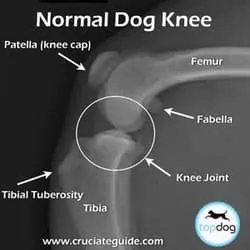The ACL (anterior cruciate ligament) in dogs is also commonly referred to as the cranial cruciate ligament. They are one and the same, one is used for people and the other for animals. Pet owners most often use the term ACL as apposed to CCL. This is what a normal dog knee looks like:

The cranial cruciate ligament is one of the main stabilizing structures of the knee. The cranial cruciate ligament serves to prevent forward movement of the tibia bone relative to the femur bone, to prevent internal rotation of the tibia bone, and to limit hyperextension of the knee.
Breeds commonly affected include Labrador Retrievers, Rottweilers, Akitas, Border collies, Huskies, German Shepherds, and Mastiffs.
Common signs of ACL injury include:
- stiffness on the limb after resting for a period of time
- varying degrees of lameness
- not bearing weight on the limb
- if the meniscus is torn sometimes a clicking noise is heard from the knee when the pet walks on the limb or when the knee is flexed
3 Most Common Types of Surgical Repair
Lateral Suture Technique

This has traditionally been the most common repair method. It is currently recommended for dogs less than 50 lbs, though dogs up to 100 lbs typically do fine with this surgical technique. Post-surgery physical therapy increases the odds of success dramatically. For this surgery a continuous mono-filament nylon suture (similar to fishing line) is placed around the fabellar bone of the femur and looped through a hole which is drilled in the tibial tuberosity. The two ends of the suture are then securely held in place using a stainless steel clip. It is the least traumatic surgery of the three procedures listed here. Dr. Marrone performs this procedure.
Tibeal Plateau Leveling Osteotomy or TPL
In the last 10 years this procedure has become a popular ACL surgery in dogs. It was invented and then patented by Dr. Barclay Slocum in 1993. The majority of its success comes from the fact that it quickly addresses the problem of the femur rubbing back and forth off the back of the tibia when the ACL is ruptured. During this surgery the surgeon using a special curved saw, makes a complete cut through the top part of the tibial bone. This piece of bone then gets rotated and plated with a stainless steel metal plate. By rotating the top of the tibia the once sloped tibial plateau now essentially becomes flat. A board certified specialist must perform this procedure.
Tibular Tuberosity Advancement or TTA
Another ACL surgery in dogs like the TPLO that has gained popularity in the last 5 years, is the TTA, though the theory behind the surgery is much different. The tibial tuberosity advancement involves making a cut down the entire tibial tuberosity, the front part of the tibia. This cut bone is then advanced forward and a specialized bone spacer is placed in the open space. Finally a stainless steel metal plate is applied in order to secure the bone in place. Because the patellar tendon attaches to this tibial tuberosity, once it is advanced, the tendon keeps the femur from sliding back and forth and therefore stabilizes the knee joint. A board certified specialist must perform this procedure.
Rehabilitation is crucial to ACL Recovery
If you where to undergo ACL surgery, your surgeon would make it mandatory for you to visit a physical therapist on a regular basis after surgery to ensure the best results. The same holds true for dog ACL recovery. It is commonly stated in veterinary medicine that dogs who tear one ACL ligament have a 30-50% chance of tearing the opposite legs ACL within a one years time. If your dog is in need of an ACL surgery, make sure you follow up with post-operative therapy. Investing time in the therapy can be equally as important as the surgery itself. There are many online resources to help in this pursuit. Topdog Animal Health and Rehabilitation offers a free brochure to get you started.
Watch Dr. Marrone perform an ACL Lateral Suture Surgery